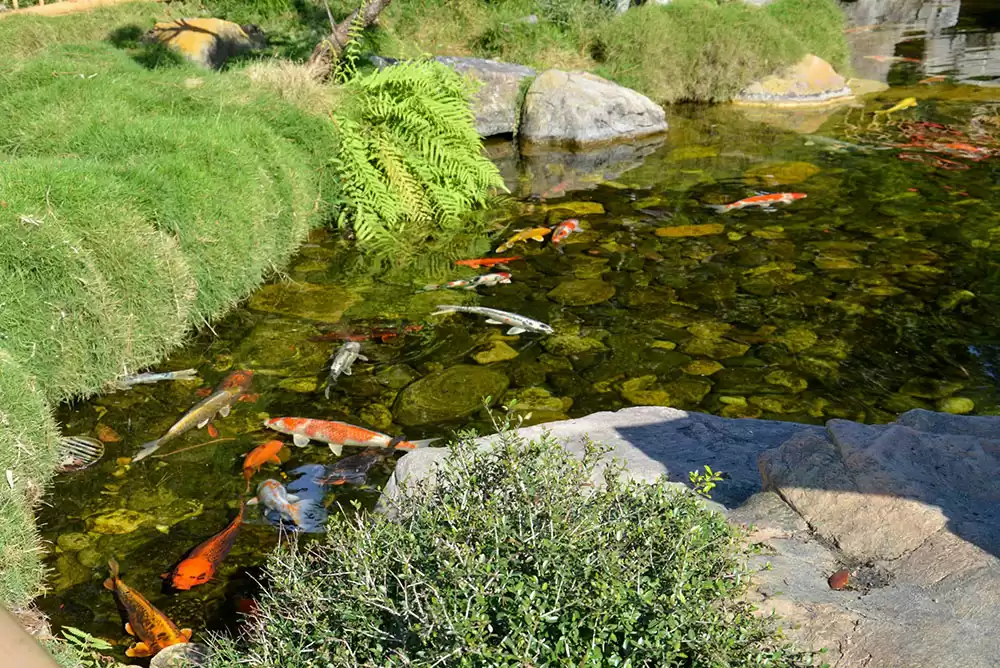
01 Feb How to Get Rid of Snails in Your Koi Pond
A koi pond is a beautiful addition to any property, but it requires careful maintenance to preserve the health of your koi and the balance of your aquatic ecosystem. One common issue many pond owners face is a snail infestation. While small numbers of snails can contribute to a pond’s ecosystem, an overpopulation can lead to serious problems. Here is how to identify, manage, and prevent snail infestations in your koi pond.
Introduction to Snail Infestations in Koi Ponds
Snails often find their way into koi ponds via new plants, equipment, or even wildlife. While some species are harmless, others can multiply rapidly, causing harm to the pond environment and competing with your koi for resources. Identifying and addressing the problem early is essential to maintaining a healthy pond.
Signs of a Snail Problem in Your Koi Pond
Look for these common indicators of a snail infestation:
- Visible Snails: Large numbers of snails on plants, rocks, or pond walls.
- Damaged Plants: Holes or bite marks on aquatic plants caused by feeding snails.
- Murky Water: Overpopulation can lead to excess waste, affecting water clarity and quality.
Impact of Snails on Pond Health and Koi
An overabundance of snails can disrupt the delicate balance of your pond’s ecosystem. They produce waste that contributes to algae growth, consume valuable nutrients, and sometimes carry parasites that can harm your koi. Ensuring control over the snail population is crucial to your pond’s overall health.
Manual Removal Methods for Snails
One of the simplest ways to reduce snail populations is through manual removal:
- Use a fine-mesh net to collect snails from pond surfaces and plants.
- Inspect plants and decorations regularly and remove any snails or eggs.
- Install a snail trap to capture and remove larger quantities efficiently.
Natural Predators of Snails in Koi Ponds
Introducing natural predators is an eco-friendly way to control snails. Fish species such as loaches or goldfish are known to feed on snails and their eggs. However, always research compatibility with your koi before adding new species to your pond.
Chemical Treatments for Snail Control
Chemical treatments can be effective but must be cautiously used to avoid harming koi and beneficial bacteria. Choose pond-safe snail control products and follow manufacturer instructions closely. Always test water parameters after applying chemicals to ensure stability.
Preventing Snail Infestations in Koi Ponds
Prevention is the most effective strategy for managing snails:
- Inspect New Plants: Rinse plants thoroughly and soak them in a potassium permanganate solution before adding them to the pond.
- Clean Equipment: Sanitize nets, pumps, and other tools before use.
- Quarantine New Additions: Isolate new fish or plants for a few weeks to monitor for snails or eggs.
Balancing the Pond Ecosystem to Control Snails
Maintaining a balanced ecosystem naturally limits snail overpopulation:
- Ensure adequate filtration to manage waste and nutrients.
- Introduce a variety of aquatic plants to compete with snails for resources.
- Monitor koi feeding to avoid excess food that could support snail growth.
Regular Maintenance Practices for Koi Ponds
Routine maintenance is key to preventing snail problems:
- Clean pond filters regularly.
- Remove debris and decaying plant material.
- Test water quality weekly to ensure optimal conditions for koi and plants.
When to Consult a Pond Care Professional
If snail infestations persist despite your efforts, consulting a pond care professional may be necessary. A professional can identify underlying issues, recommend advanced solutions, and provide ongoing maintenance to keep your pond in pristine condition.
Addressing snail infestations promptly protects your koi and preserves the beauty of your pond. You can maintain a balanced, thriving aquatic environment by combining prevention, natural methods, and professional advice.



